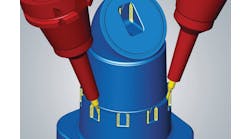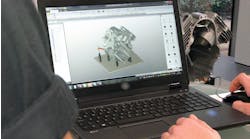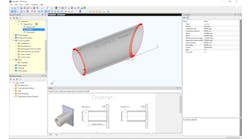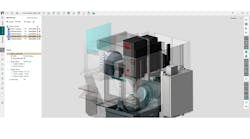Twenty-one years ago the Rietsma brothers, Tim and Mike, started a mold-and-die shop in Zeeland, Michigan, aiming to contribute to the long tradition of toolmaking. But machine tool technology and the toolmaking profession have changed dramatically since then, and with the changes have come new ways of doing things. The changes have challenged their business and their ideals.
Qualified toolmakers have become scarce, and though the standards of the trade have always been maintained by developing skilled and well-rounded toolmakers, trade schools were preparing candidates for jobs in basic machine operation.
Recently, Tim Rietsma observed, “When we started our company, I had 15 years of experience building molds and my brother had 20 years’ experience building stamping dies. The toolmaker that we had in the 1990s, I don’t think we’ll ever see that type of person again.”
Dual-edged technology. Contour Tool & Engineering, the original name of the mold-and-die business, is now True Die Inc., following a new ownership investment, the addition of new round product tooling capabilities, and a renewed commitment to the toolmaking trade. As Contour Tool, the company was a one-stop resource for OEMs needing an integrated knowledge and approach to building molds for injection molded plastic parts. According to the Rietsma brothers, as True Die Inc. the company’s heritage can now be more fully leveraged.
“As we design and machine a tool, we’re thinking about what goes into the finished part,” Tim Rietsma explained. “We see a problem at any step and we are able to solve it. Once that’s done, the rest is basically the machining.
“I’ve had job-placement services come to me offering their services,” he continued. “I tell them I need a moldmaker or a die builder. They come back with someone who went to tech school and who knows how to run a basic machine to cut a part. Then they say, ‘Well, that’s what you do here, right? Cut parts?’”
For True Die, two paths forward have emerged: Invest in newer basic machines that give a machine operator the ability to cut a part; or invest in more capable machine/control packages that enable employees to build their skills, their careers – and the company.
In 2014, the company bought its first ROMI machine, driven by its first Siemens CNC. The ROMI D1000AP vertical machining center featured the Siemens Sinumerik 828D control and drives package.
“We initially wanted higher speed and accuracy,” Tim Rietsma recalled. “With the molds, you cut both halves of the tool, then both halves need to fit tight to each other… within one-thousandth of an inch. If your machine can’t do this, you must spend a lot of time with a hand grinder on a bench.”
Doing away with bench grinding proved to be one of the immediate paybacks of the ROMI-Siemens investment. Any grinding-related variances in precision and surface quality were soon avoided and the profitability of the business was boosted by the increased capacity for throughput.
“Three years ago, most of our surfacing work was done at a feed rate of around fifty to sixty inches per minute,” Rietsma said. “With the Siemens and the ROMI combination, some of our feed-rates have already approached 200 inches per minute, and what comes out of the machine is a part cut in much less time; and that offers repeated high quality to the customer.”
The new machine/control package has yielded other important returns that make True Die’s investment look all the better with each passing day.
One-pass drilling. The ROMI D1000AP vertical machining center features integrated cooling during high-speed drilling. The coolant flows through the drill bit to flush the metal chips out and away from the flutes. Carbide drill bits last much longer, and drilling cycles have been reduced from five minutes to thirty seconds.
Now the shop can drill a hole in one pass, rather than repeating up-and-down passes to clear metal chips from the hole and bit. “So, the price for a tool may be quoted at twenty-five dollars for each of five holes,” Tim Rietsma explained. “Whatever the going rate, we can produce five of those holes in the time it used to take to produce one.”
This feature alone gives True Die Inc. the flexibility to increase its margins or to quote jobs strategically, to win new business, and sometimes both.
Faster-to-the-finish. At every turn, the mold-and-die professionals at True Die have discovered something remarkable about the Sinumerik 828D CNC that drives their new ROMI machining center. An important discovery was the ability to program the machine to minimize the time it takes to cut a part.
A feature called “Advance Surface” allows the shop to optimize mold-cutting velocity, accuracy, and surface quality for the most efficient machining motion. For example, machine speed (velocity) can be reduced when the tool path requires precise cutting of sharp corners (accuracy) and accelerated when machining through rough cuts to produce a part to the exact finish requirements (surface quality.)
“It’s a feature that is over the top of any control I’ve ever seen,” Rietsma said. “With a couple short clicks on the control, I can tell the machine that a particular block is not so fussy on tolerance. I can in effect say, ‘open the tolerance up’ and that will increase the speed of the machine through that sequence. We can get the surface finish that the mold requires and the maximum speed of the machine all at the same time.”
Beyond easy-to-use. Just about every CNC is described as easy-to-use, but seeing is believing, he continued. “Siemens has definitely outdone all their competitors. The CNC has full graphical support. You see what you’re doing while you’re putting in a program. With a lot of the other controls, you’re looking at the book trying to figure out what things mean.”
Investing in an easier-to-use Siemens control that drives an advanced ROMI machine was not the end-game for True Die, Inc. The greater goals were empowering the shop’s people, strengthening the business, and contributing to a toolmaking profession that was built on knowledge and skill development.
Beyond “conversational,” the Siemens-ROMI investment is enabling the shop’s employees to expand their knowledge and enhance their skills. “We’re still learning on the machine, learning every week,” Tim Rietsma said. “When the machine hit the floor, we needed to make parts. We didn’t have time to really learn the CNC. And then as the weeks go on, we learn a little more. The sky’s the limit with the Sinumerik 828D.”
Other proven returns on the machine/control investment have been faster production of consistent quality molds; leveraging True Mold’s newfound flexibility to produce different parts for different types of customers on the same machine; naming and calling up any of the tools in the tool holder; reducing mold rib cutting from a 20-hour off-line EDM process to a 1.5 hour milling process at the machine; eliminating hours of “homing” restart time in the mornings due to a Siemens absolute encoder that holds the exact previous setting; and being able to download earlier Haas and Fanuc files into the Siemens control, with no losses and greater machining flexibility to gain.
Looking ahead. Brian Brown, True Die Inc. owner and president, is especially proud of the company’s position and outlook on toolmaker education. A journeyman toolmaker himself, he is passionate about protecting and growing the trade by adopting more enabling technology and more robust education.
“Our business has a state-certified apprenticeship program,” Brown pointed out. “And our business is uplifted by companies like Siemens and ROMI, who understand the challenges of our industry. In fact, to further enhance our market / product offering, we just purchased our second ROMI to machine round tools for the deep-draw industry... a C420 lathe with a Sinumerik 828D control that will be used strictly for hard turning.
“This approach will minimize the need to ID/OD grind round tools after heat treating,” he continued. “Hard turning can hold comparable surface finishes and tolerances to grinding, but it is a much more efficient process.”
The toolmaker’s trade may have changed but for True Die Inc., the way forward includes investing in more open-ended technology that will build knowledge and skills, encourage inventive thinking, and reward career-minded workers who bring new ideas to the shopfloor.
John Meyer is the Manager of Marketing Communications at Siemens Inc.








